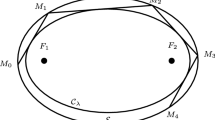Abstract
Defocusing mechanism provides a way to construct chaotic (hyperbolic) billiards with focusing components by separating all regular components of the boundary of a billiard table sufficiently far away from each focusing component. If all focusing components of the boundary of the billiard table are circular arcs, then the above separation requirement reduces to that all circles obtained by completion of focusing components are contained in the billiard table. In the present paper we demonstrate that a class of convex tables—asymmetric lemons, whose boundary consists of two circular arcs, generate hyperbolic billiards. This result is quite surprising because the focusing components of the asymmetric lemon table are extremely close to each other, and because these tables are perturbations of the first convex ergodic billiard constructed more than 40 years ago.
Similar content being viewed by others
References
Bunimovich L.A.: On billiards closed to dispersing. Mate. Sb. 95, 49–73 (1974)
Bunimovich L.A.: On ergodic properties of certain billiards. Funct. Anal. Appl. 8, 254–255 (1974)
Bunimovich L.A.: On the ergodic properties of nowhere dispersing billiards. Commun. Math. Phys. 65, 295–312 (1979)
Bunimovich L.A., Del Magno G.: Track billiards. Commun. Math. Phys. 13, 699–713 (2009)
Chen J., Morh L., Zhang H.-K., Zhang P.: Ergodicity and coexistence of elliptic islands in a family of convex billiards. Chaos 23, 043137 (2013)
Chernov, N., Markarian, R.: Chaotic billiards. Mathematical Surveys and Monographs, vol. 127. AMS, Providence (2006)
Chernov N., Zhang H.-K.: Billiards with polynomial mixing rates. Nonlinearity 18, 1527–1553 (2005)
Donnay V.: Using integrability to produce chaos:billiards with positive entropy. Commun. Math. Phys. 141, 225–257 (1991)
Douady, R.: Applications du théorème des tores invariants. Thèse 3-eme cycle, University of Paris 7 (1982)
Heller E., Tomsovic S.: Postmodern quantum mechanics. Phys. Today 46, 38–46 (1993)
Khinchin A.Ya.: Continued Fractions. The University of Chicago Press, Chicago (1964)
Lazutkin V.F.: Existence of a continuum of closed invariant curves for a convex billiard. Math. USSR Izv. 7, 185–214 (1973)
Lopac V., Mrkonjic I., Radic D.: Classical and quantum chaos in the generalized parabolic lemon-shaped billiards. Phys. Rev. E 59, 303–311 (1999)
Lopac V., Mrkonjic I., Radic D.: Chaotic behavior in lemon-shaped billiards with elliptical and hyperbolic boundary arcs. Phys. Rev. E 64, 016214 (2001)
Markarian R.: Billiards with polynomial decay of correlations. Ergod. Theor. Dyn. Syst. 24, 177–197 (2004)
Makino H., Harayama T., Aizawa Y.: Quantum-classical correspondences of the Berry–Robnik parameter through bifurcations in lemon billiard systems. Phys. Rev. E 63, 056203 (2001)
Oliffson Kamphorst S., Pinto-de-Carvalho S.: The first Birkhoff coefficient and the stability of 2-periodic orbits in billiards. Exp. Math. 14, 299–306 (2005)
Ree, S., Reichl, L.E.: Classical and quantum chaos in a circular billiard with a straight cut. Phys. Rev. E 60(9), 1607 (1999)
Sinaǐ Ya.: Dynamical systems with elastic reflections. Ergodic properties of diepersing billiards. Russ. Math. Surv. 25, 137–189 (1970)
Wojtkowski M.: Principles for the design of billiards with nonvanishing Lyapunov exponents. Commun. Math. Phys. 105, 391–414 (1986)
Author information
Authors and Affiliations
Corresponding author
Additional information
Communicated by K. Khanin
Rights and permissions
About this article
Cite this article
Bunimovich, L., Zhang, HK. & Zhang, P. On Another Edge of Defocusing: Hyperbolicity of Asymmetric Lemon Billiards. Commun. Math. Phys. 341, 781–803 (2016). https://doi.org/10.1007/s00220-015-2539-x
Received:
Accepted:
Published:
Issue Date:
DOI: https://doi.org/10.1007/s00220-015-2539-x




